Aldebaran, Alpha Tauri (α Tau), is an orange giant star located 65.3 light-years away in the constellation Taurus. With an apparent magnitude that varies from 0.75 to 0.95, it is the brightest star in Taurus and the 14th brightest star in the sky.
Aldebaran lies in the same line of sight as the Hyades cluster and marks the eye of the celestial Bull. The evolved star hosts a giant exoplanet, Aldebaran b, whose existence was confirmed in 2015.
Star type
Aldebaran is a giant star of the spectral type K5+ III. The aging giant is currently on the red giant branch (RGB), in the hydrogen shell burning phase. It has exhausted the hydrogen supply in its core and, as it evolved away from the main sequence, it started to expand to its current size.
Aldebaran has a mass of 1.16 solar masses and a radius 45.1 times that of the Sun. With a surface temperature of 3,900 K, it shines with a luminosity 439 times that of the Sun. A lot of the star’s energy output is in the invisible infrared.
The red giant star is a relatively slow spinner. With a projected rotational velocity of around 3.5 km/s, it takes 520 days to complete a rotation. It has a metallicity around 30% lower than the Sun’s and an estimated age of 6.4 billion years.
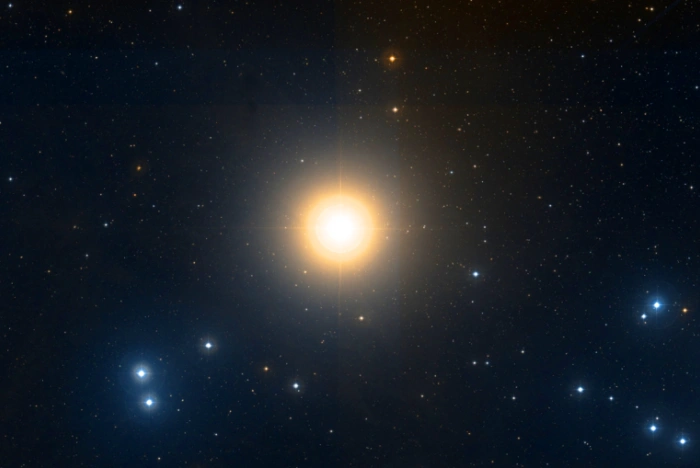
Aldebaran (Alpha Tauri), image credit: ESO/Digitized Sky Survey 2 (CC BY 4.0)
Aldebaran is shedding mass at a rate of (1–1.6) × 10−11 M⊙ yr−1, or one Earth mass every 300,000 years, through a strong stellar wind.
The star’s MOLsphere – the molecular layer beyond the chromosphere – stretches across a distance 2.5 times the star’s radius and has a temperature of 1,500 K. Lines of water, carbon monoxide and titanium oxide have been detected in its spectrum.
Aldebaran’s stellar wind expands beyond the MOLsphere, until it reaches the boundary with the interstellar medium, where it slows down to subsonic speed. It forms an astrosphere that extends for about 1,000 astronomical units from the star.
Alpha Tauri is classified as a slow irregular variable (LB) star. Its brightness varies from magnitude 0.75 to 0.95 according to historical records given in the General Catalogue of Variable Stars (GCVS). However, modern observations have shown that the variations have a smaller amplitude. Some of the studies have even shown almost no variation.
The epoch photometry of the Hipparcos catalogue indicates that the star’s brightness varies by only 0.02 magnitudes over a possible period of about 18 days. Ground-based photometry found an amplitude of up to 0.03 magnitudes with a possible period of about 91 days. Long-term observations have found irregular variations by less than 0.1 magnitudes.
Aldebaran has several faint visual companions. The first one was discovered by the German-born British astronomer William Herschel in 1782. It is an 11th magnitude star separated by 117 arcseconds from Aldebaran.
In 1888, a full century later, the American astronomer Sherburne Wesley Burnham observed the star and found that it was a close binary system. Burnham found another companion, a 14th magnitude star, at a separation of 31 arcseconds.
The companion discovered by Herschel does not have a similar proper motion to Aldebaran. However, the second star has almost the same parallax and proper motion as its bright neighbour, indicating that the two stars are physically related and form a wide binary system. Since the companion appears so close to the bright Aldebaran, it is difficult to unambiguously confirm that the two stars are related.
Aldebaran’s line-of-sight companions have been designated Alpha Tauri B, C, D, E, and F in order of discovery. Alpha Tauri B has the stellar classification M2.5 and an apparent magnitude of 13.60. Alpha Tauri C is the brightest of the companions, with a visual magnitude of 11.30.
Alpha Tauri D, E and F have apparent magnitudes of 13.70, 12.00 and 13.60. Alpha Tauri C and Alpha Tauri D are gravitationally bound to each other and form a binary system. They are located at a much greater distance from us than Aldebaran and belong to the Hyades cluster.
None of the five visual companions have been confirmed as physical companions to Aldebaran.
Size
Aldebaran has a radius of 45.1 solar radii. The value comes from a 2015 study of long-period radial velocity variations in the giant. It is based on Aldebaran’s angular diameter used for the Gaia benchmark calibration, 20.580 ± 0.030 milliarcseconds.
The star has a limb darkened angular diameter of 20.57 ± 0.02 mas based on interferometric measurements. This corresponds to a physical radius 44.13 ± 0.84 times that of the Sun, or around 61 million kilometres.
Aldebaran is larger than the fellow K-type giants Pollux (9.06 solar radii), Arcturus (25.4 R☉) and Unukalhai (12.19 R☉), but it does not rival the supergiants Antares (680 R☉), Rigel (74.1 R☉) and Betelgeuse (640 – 764 R☉). It certainly does not come close to the size of some of the largest stars known, including UY Scuti (909 R☉), Mu Cephei (972 – 1,420 R☉), VY Canis Majoris (1,420 R☉,) AH Scorpii (1,411 R☉), VX Sagittarii (1,360 R☉), NML Cygni (1,350 R☉), RSGC1-F01 (1,450 – 1,530 R☉), and Stephenson 2-18 (2,150 R☉).
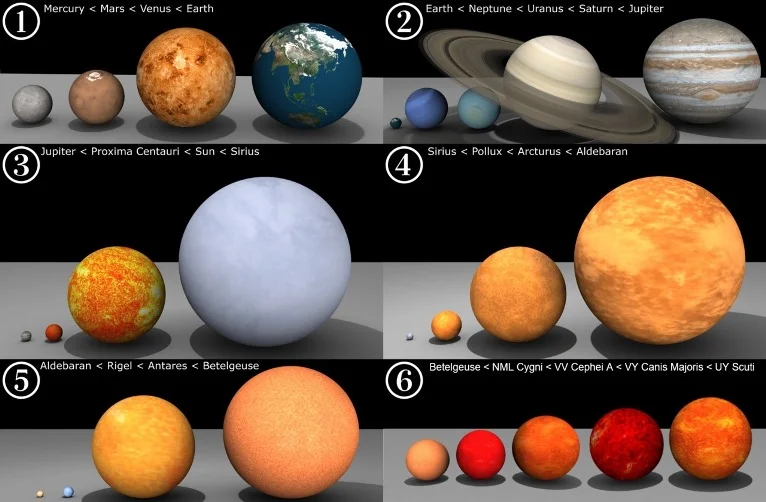
Size comparison of planets and stars, image: Wikimedia Commons/Dave Jarvis, Jcpag2012, JoeyPknowsalotaboutthat (CC BY-SA 4.0)
Planet
The presence of a planet orbiting Aldebaran was proposed in 1993, but its existence was only hypothetical until 2015. Even though Aldebaran b was confirmed in 2015, its existence is still disputed.
In 1993, a study measuring long-period radial velocity variations in three class K giants – Aldebaran, Arcturus and Pollux – found periods of 643 days for Aldebaran, 233 days for Arcturus and 558 days for Pollux. These periods are too long to be a result of radial pulsations. They can only be explained by surface features coupled with rotation, non-radial pulsations or the presence of a planet.
However, the study concluded that the cause was likely intrinsic to the stars. Based on its findings, a hypothetical planet orbiting Aldebaran would have a mass of at least 11.4 Jupiter masses and orbit the star with a period of 643 days from a distance of 2 astronomical units.
In 2015, a team of astronomers investigated the nature of the radial velocity variations and analyzed precise measurements taken over a period of 30 years. They found evidence for both rotation modulation by stellar surface structure and an orbiting planet with a mass of at least 6.47 Jupiter masses and an orbital semi-major axis of about 1.46 astronomical units.
In 2018, an asteroseismic study determined a mass of at least 5.8 ± 0.7 Jupiter masses for Aldebaran b. The researchers found that while the planet is now likely very hot – the estimated temperature is 1,500 K due to its proximity to the giant host star – it probably had a similar temperature to that of the Earth before Aldebaran evolved away from the main sequence. This means that Aldebaran b may have been habitable billions of years ago. The planet orbits the star from a distance of 1.46 astronomical units.
In 2019, the planet’s existence was cast into doubt by an analysis of new radial velocity data collected by the Lick Observatory in California, which did not support the presence of the planet. The study suggested that two planets with at least several Jupiter masses would fit the data more closely but would not explain the radial velocity variations observed in the star.
The researchers concluded that the variations were likely caused by an intrinsic property of the star and not gravitational interaction with a planetary companion.
Facts
Aldebaran is the 14th brightest star in the night sky. It is usually slightly fainter than Altair in the constellation Aquila and Acrux in Crux, but just outshines Antares, Spica and Pollux, the luminaries of Scorpius, Virgo and Gemini.
Aldebaran was the brightest star in the sky for about 200,000 years between the years 420,000 and 210,000 BCE. The star came within 21.5 light years of the solar system. At its maximum, it shone at magnitude -1.54 and was slightly brighter than Sirius is today (mag. -1.46).
Aldebaran is the fourth brightest star in the sky in near-infrared wavelengths. With a J-band magnitude of -2.1, it is only outshone by Betelgeuse (-2.99), R Doradus (-2.6) and Arcturus (-2.2).
Aldebaran is the brightest of all stars in zodiac constellations. It narrowly outshines Antares in Scorpius. It is also brightest than the first magnitude stars Spica in Virgo, Pollux in Gemini, and Regulus in Leo.
Aldebaran is one of the two stars in Taurus that are included on the list of the 58 navigational stars. The constellation’s other navigational star is Elnath, Beta Tauri. Navigational stars are some of the brightest and best-known stars in the sky. They were selected for use in the field of celestial navigation because they are easily recognizable, both because of their brightness and because they are part of or appear next to a prominent asterism.
Aldebaran is one of the six first-magnitude stars that form the Winter Circle (Winter Hexagon), a bright, large asterism that dominates the evening sky during the northern hemisphere winter. The asterism contains the smaller Winter Triangle and most of the constellation Orion within its borders. The stars that form the Winter Hexagon are Aldebaran, Capella in the constellation Auriga, Pollux in Gemini, Procyon in Canis Minor, Sirius in Canis Major, and Rigel in Orion.
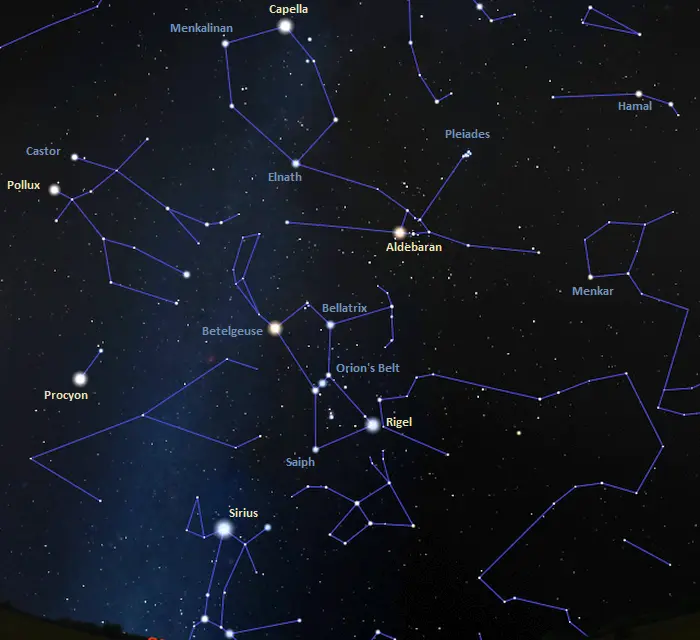
The stars of the Winter Hexagon: Rigel, Sirius, Procyon, Pollux, Capella, and Aldebaran, image: Stellarium
Aldebaran lies in the same line of sight as the Hyades, the nearest open star cluster to Earth. The V-shaped cluster outlines the head of the celestial Bull and Aldebaran appears as its brightest member even though it is not. The star lies only 65.3 light years away, while the cluster is located at more than twice the distance (153 light years).
Aldebaran and Ain (Epsilon Tauri) mark the Bull’s eyes. Unlike Aldebaran, Ain is a member of the Hyades. It is an orange giant star that shines at magnitude 3.53 from a distance of 146 light-years. The star’s traditional name, Ain, is Arabic for “eye.”
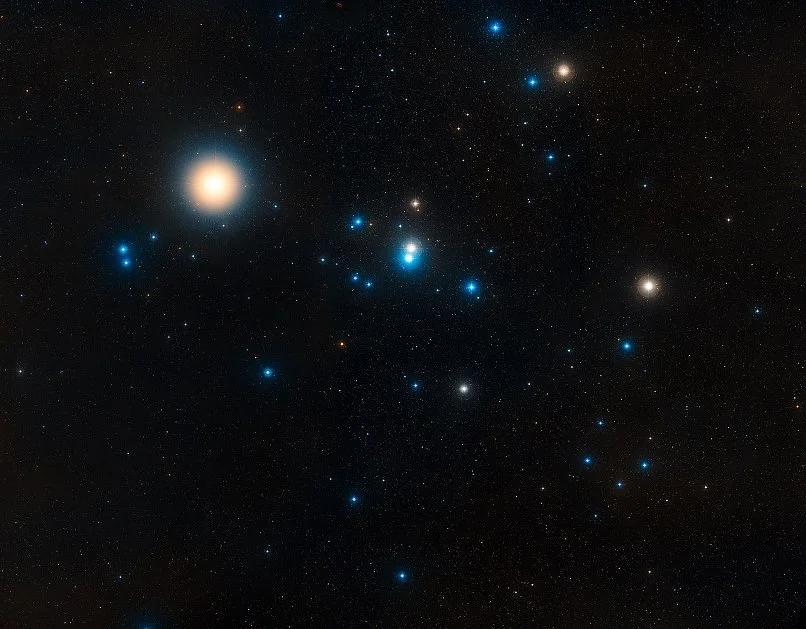
This image shows the Hyades star cluster, the nearest cluster to us. The Hyades cluster is very well studied due to its location, but previous searches for planets have produced only one. A new study led by Jay Farihi of the University of Cambridge, UK, has now found the atmospheres of two burnt-out stars in this cluster — known as white dwarfs — to be “polluted” by rocky debris circling the star. Seeing evidence of asteroids points to the possibility of Earth-sized planets in the same system, as asteroids are the building blocks of major planets. Planet-forming processes are inefficient, and spawn many times more small bodies than large bodies — but once rocky embryos the size of asteroids are built, planets are sure to follow. Image: NASA, ESA, and STScI, 2013 (CC BY-SA 4.0)
Aldebaran is one of the bright stars whose movement across the sky led to the discovery of proper motion. In 1718, the English astronomer and mathematician Edmund Halley studied the records of the lunar occultation of the star that occurred on March 11, 509 CE and was seen from Athens, Greece. He found that the star had moved several arcminutes to the north since that time.
Halley compared his measurements with the data Ptolemy provided in his Almagest in the 2nd century CE and noted that Sirius and Arcturus had also moved significantly. This led to the realization that what were previously believed to be “fixed” stars were not so fixed after all.
Aldebaran is used as the spectral standard for its class, K5+ III, in The Perkins Catalog of Revised MK Types for the Cooler Stars (1989).
The first person to study Aldebaran’s spectrum was the English astronomer and astronomical spectroscopy pioneer Sir William Huggins, who observed the giant star from his private observatory in Tulse Hill, London in 1864. Huggins was able to identify nine elements in Aldebaran’s spectral lines, including iron, sodium, calcium and magnesium.
American astronomer and physicist Edward Charles Pickering, who is credited for the discovery of the first spectroscopic binary star systems, captured 50 absorption lines in Aldebaran’s spectrum using a photographic plate at Harvard College Observatory, where he was director, in 1886. His findings were published in the Draper Catalogue of Stellar Spectra in 1890.
Aldebaran is one of the most studied stars in the sky. Its substantial record of observations and studies led to it being used to calibrate the instruments of the Hubble Space Telescope.
Aldebaran is also one of the 33 stars used as benchmarks to calibrate the stellar parameters during the Gaia space observatory mission (2013 – 2022), launched to take precise astrometric measurements and create the largest 3D space catalogue of the Milky Way to date.
The surface gravity of Aldebaran is 1.59 cgs, about 25 times lower than our planet’s and 700 times lower than the Sun’s, but not unusual for a giant star.
Aldebaran lies only 5.47 degrees south of the ecliptic, the Sun’s apparent path across the sky, and can be occulted by the Moon. An occultation that occurred on September 22, 1978, allowed astronomers to get a fairly accurate estimate for the star’s diameter.
Between January 29, 2015, and September 3, 2018, 49 occultations of the star could be seen from locations near the equator and in the northern hemisphere. The Sun comes close to Aldebaran around May 30 – June 1 every year.
About 5,000 years ago, Aldebaran was close to the vernal equinox, the point where the Sun crosses the celestial equator, marking the beginning of spring in the northern hemisphere. Due to the Earth’s axial precession, the star has since moved away.
Aldebaran’s recession velocity was first calculated as 48 km/s by the German astrophysicist Hermann Carl Vogel and his assistant, the astronomer Julius Scheiner, at the Astrophysical Observatory Potsdam in Germany in the late 1880s.
In 1921, American astronomer Francis G. Pease used a 20-foot interferometer and the 100-inch Hooker refractor at the Mount Wilson Observatory in California to measure the angular diameters of Aldebaran, Arcturus, and other stars. However, he was unable to resolve the star.
Aldebaran’s angular diameter has been measured many times since. The most recent value is 20.580 ± 0.030 milliarcseconds, provided for the Gaia benchmark calibration in 2015.
In medieval astrology, Aldebaran was one of the 15 Behenian fixed stars, believed to be a source of special astrological power. It was associated with the planets Venus and Mars. Each Behenian star was linked with a plant and a gemstone – in Aldebaran’s case, milk thistle and ruby – and these would be used in rituals and charms to bring out the star’s influence.
The space Probe Pioneer 10, launched in 1972, is headed in the general direction of the star. It would take more than two million years to make its closest approach to Aldebaran if the star had zero relative velocity.
Aldebaran has been used and referenced in countless works of fiction. Some of the best known mentions include H. P. Lovecraft’s The Cthulhu Mythos (1921- ), E. E. “Doc” Smith’s novels in the Lensman series (1934 –1948), Leigh Brackett’s The Starmen (1952), Alfred Bester’s The Stars My Destination (1956), Stanisław Lem’s short story collection The Invasion from Aldebaran (1959), Ursula K. Le Guin’s novel The Lathe of Heaven (1971), Joe Haldeman’s The Forever War (1974), Douglas Adams’ The Hitchhiker’s Guide to the Galaxy (1979), Yoshiki Tanaka’s novel series Legend of the Galactic Heroes (1982-1987), Frederik Pohl’s novel Narabedla Ltd. (1988), Kim Stanley Robinson’s Blue Mars (1996), Peter F. Hamilton’s Fallen Dragon (2001), and Keith Hamilton’s Johnny Mackintosh: Star Blaze (2010).
In film and television, Aldebaran was memorably referenced in multiple episodes of Star Trek, including “Where No Man Has Gone Before” (1966) and “Amok Time” (1967) in Star Trek: The Original Series, and “Hide and Q” (1987) in Star Trek: The Next Generation.
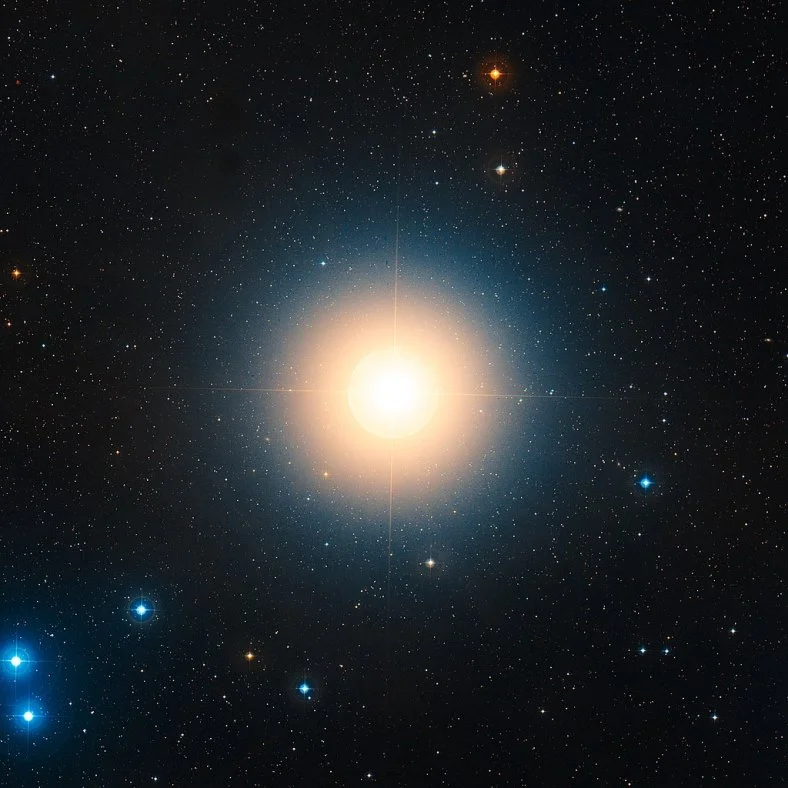
Aldebaran, image: NASA, ESA, and STScI (CC BY-SA 4.0)
Name
The name Aldebaran (pronunciation: /ælˈdɛbərən/) comes from the Arabic al Dabarān, meaning “the follower.” It refers to the star following the bright Pleiades cluster across the sky. The name is derived from the phrase Nā᾽ir al Dabarān, “the bright one of the follower,” which was the star’s original name.
The name was officially approved by the International Astronomical Union’s (IAU) Working Group on Star Names (WGSN) on June 30, 2016.
Aldebaran was historically also known as Oculus Australis, which is Latin for the “southern eye.” The fainter Ain (Epsilon Tauri) was known as Oculus Borealis, the “northern eye.” The two stars mark the eyes of the celestial Bull.
The Chinese knew Aldebaran as 畢宿五 (Bì Xiù wǔ), or the Fifth Star of Net. In traditional Chinese astronomy, the Net asterism was formed by Aldebaran with Ain (Epsilon Tauri), Prima Hyadum (Gamma Tauri), Secunda Hyadum (Delta1 Tauri), Delta3 Tauri, Chamukuy (Theta1 Tauri), 71 Tauri, and Lambda Tauri. The asterism was part of the larger Net mansion, which represented the body of the White Tiger.
In Hindu astronomy, Aldebaran is associated with the Rohini lunar mansion. In Hindu mythology, Rohini (“the red one” or “red deer”) was one of the daughters of Daksha, the son of Lord Brahma who created the nakshatras (lunar mansions), and wives of Chandra, the Moon God, who married all her sisters at her father’s request even though he only wanted to marry her.
In ancient Greece, the star was known as Λαμπαδίας (Lampadias), which means “torch bearer” or “torch-like.”
In Babylonian astronomy, Aldebaran formed an asterism known as Pidnu-sha-Shame, the Furrow of Heaven.
The ancient Persians regarded it as one of the four Royal Stars of Persia. The four stars – Aldebaran, Regulus, Fomalhaut and Antares – were seen as the guardians of the sky. In Persian astronomy, the sky was divided into four districts and each was guarded by one of the stars. Aldebaran was known as the Watcher of the East.
The Seri people of Mexico have several names for Aldebaran: Queeto, Hant Caalajc Ipápjö, and Azoj Yeen oo Caap. The last one means “the star that goes ahead.” In local lore, the star gives light for seven women giving birth, represented by the Pleiades cluster. The month that corresponds to October is known as Queeto yaao, meaning “Aldebaran’s path.”
The Aboriginal people of the Clarence River in New South Wales saw the star as the Ancestor Karambal. In Aboriginal folklore, Karambal was a man who fell in love with Meamei, one of the Pleiades, but when he carried her off to be his wife, her sisters forced him to release her. He then stole the wife of Bullabogabun, a great warrior, who followed the lovers’ tracks and quickly overtook them. In the tale, Karambal left the warrior’s wife and climbed a tall tree to hide. Bullabogabun burned the tree down and Karambal was lifted up into the sky by flames and became Aldebaran, where he still pursues the Pleiades through the sky.
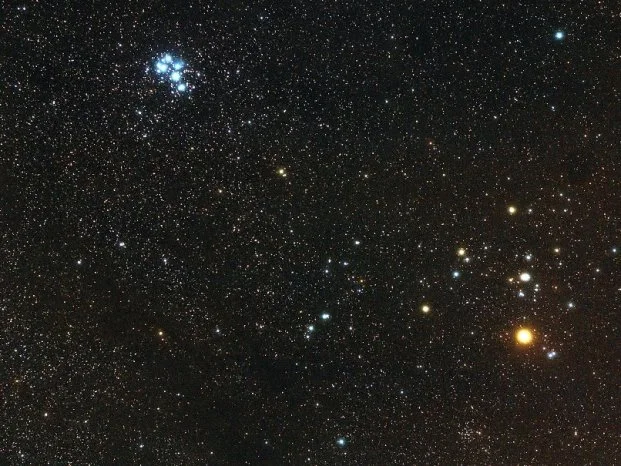
Pleiades, Hyades and Aldebaran, image: Giuseppe Donatiello (CC0 1.0)
Location
Aldebaran is very easy to find and identify because it is one of the brightest stars in the sky and also because it has one of the best known asterisms – the Orion’s Belt – pointing at it.
Aldebaran is the brightest star in the region between the Belt and the Pleiades. A line extended from the Belt stars, Alnitak, Alnilam and Mintaka, in the direction of the Pleiades leads directly to the star. In the opposite direction, the three stars point toward Sirius, the brightest star in the sky.
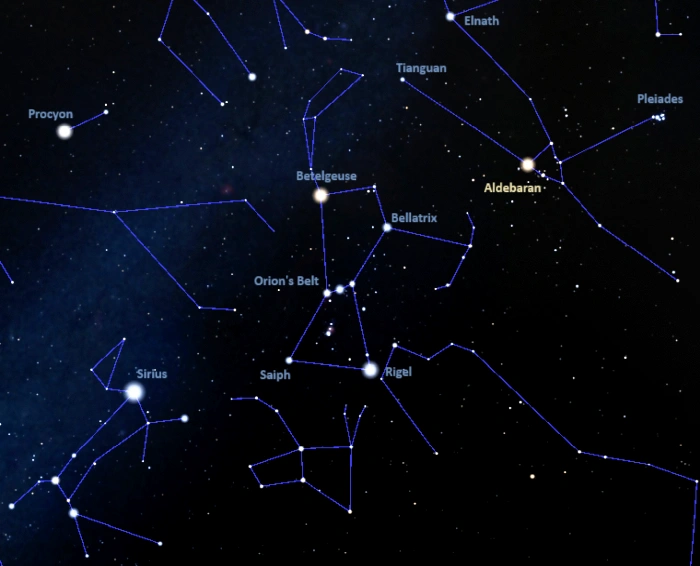
The location of Aldebaran (Alpha Tauri), image: Stellarium
Constellation
Aldebaran is located in the zodiac constellation Taurus. Representing the celestial bull, Taurus is one of the Greek constellations catalogued by Claudius Ptolemy in his Almagest in the 2nd century CE. It is one of the oldest and best-known constellations in the sky. In Greek mythology, it is associated with the tale of Zeus assuming the form of a white bull to seduce the princess Europa.
Taurus is the 17th largest of the 88 constellations. It stretches across 797 square degrees of the predominantly northern sky. Like all constellations of the zodiac, it lies on the ecliptic, the Sun’s apparent path across the sky. The Bull is also one of the 15 equatorial constellations and can easily be seen from both hemispheres.
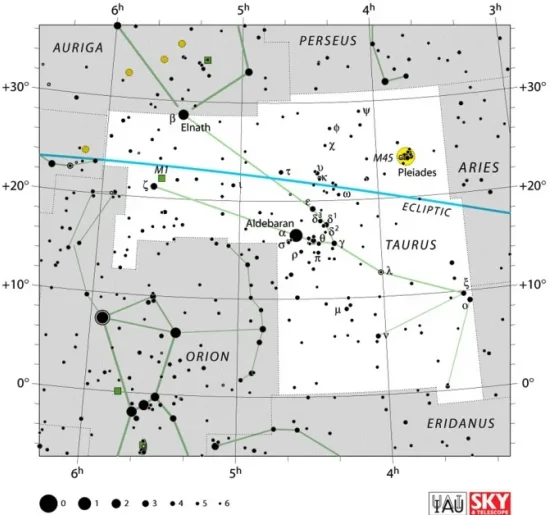
Taurus constellation map by IAU and Sky&Telescope magazine (Roger Sinnott & Rick Fienberg) (CC BY 3.0)
The constellation is best known for hosting Aldebaran, one of the brightest stars in the sky, and two bright, nearby open star clusters – the Pleiades (Messier 45) and the Hyades.
The Pleiades cluster marks the Bull’s shoulder and the Hyades its head. The relatively bright stars Elnath (Beta Tauri) and Tianguan (Zeta Tauri) mark the Bull’s horns.
Other notable deep sky objects in Taurus include the Crab Nebula (Messier 1), a historic supernova remnant, the supernova remnant Sh2-240, also known as the Spaghetti Nebula, Hind’s Variable Nebula (NGC 1555), a young reflection nebula illuminated by the variable pre-main sequence star T Tauri, the Crystal Ball Nebula (NGC 1514), a planetary nebula that made William Herschel reconsider his beliefs about the starry nature of these objects, and the colliding galaxies NGC 1410 and NGC 1409.
The best time of the year to observe the stars and deep sky objects of Taurus is during the month of January, when the constellation is higher above the horizon in the early evening. The entire constellation is visible from locations between the latitudes 90° N and 65° S.
The 10 brightest stars in Taurus are Aldebaran (Alpha Tau, mag. 0.86), Elnath (Beta Tau, mag. 1.65), Alcyone (Eta Tau, mag. 2.87), Tianguan (Zeta Tau, mag. 2.97), Chamukuy (Theta2 Tauri, mag. 3.40), Lambda Tauri (mag. 3.47), Ain (Epsilon Tau, mag. 3.53), Omicron Tauri (mag. 3.61), Atlas (27 Tau, mag. 3.63), and Prima Hyadum (Gamma Tau, mag. 3.654).
Aldebaran – Alpha Tauri
| Spectral class | K5+ III |
| Variable type | Slow irregular variable (LB) |
| U-B colour index | +1.92 |
| B-V colour index | +1.44 |
| Apparent magnitude | 0.86 (0.75–0.95) |
| Apparent magnitude (J) | -2.095 |
| Absolute magnitude | −0.641 ± 0.034 |
| Distance | 65.3 ± 1.0 light-years (20.0 ± 0.3 parsecs) |
| Parallax | 49.97 ± 0.75 mas |
| Radial velocity | +54.398 ± 0.0008 km/s |
| Proper motion | RA: 63.45 ± 0.84 mas/yr |
| Dec.: −188.94 ± 0.65 mas/yr | |
| Mass | 1.16 ± 0.07 M☉ |
| Luminosity | 439 ± 17 L☉ |
| Radius | 45.1 ± 0.1 R☉ |
| Temperature | 3,900 ± 50 K |
| Metallicity | −0.33 ± 0.1 dex |
| Age | 6.4 billion years (5.3 – 7.8 billion years) |
| Rotational velocity | 3.5 ± 1.5 km/s |
| Rotation | 520 days |
| Surface gravity | 1.45 ± 0.3 cgs |
| Constellation | Taurus |
| Right ascension | 04h 35m 55.23907s |
| Declination | +16° 30′ 33.4885″ |
| Names and designations | Aldebaran, Alpha Tauri, α Tauri, α Tau, 87 Tauri, HD 29139, HR 1457, HIP 21421, GC 5605, GCRV 2689, SAO 94027, BD+16°629, AG+16 400, GJ 9159 A, GJ 171.1 A, FK5 168, LTT 11462, NLTT 13584, PPM 120061, GSC 01266-01416, IRC +20087, JP11 898, PLX 1014, RAFGL 601, BU 550A, BU 1031A, IRAS 04330+1624, 2MASS J04355524+1630331, SKY# 7128, SRS 30168, TD1 3349, LTT 11462, UBV 4426, UBV M 10223, N30 962, YZ 16 1233, TIC 245873777, USNO-B1.0 1065-00048822, AP J04355524+1630331, ASCC 838711, CEL 436, CNS5 1142, CSI+16 629 1, CSV 6116, PMC 90-93 119, GALAH 141102003801353, LSPM J0435+1630, ROT 655, GAT 1331, GEN# +1.00029139, GES J04355530+1630309, uvby98 100029139, WEB 4111, TYC 1266-1416-1, ADS 3321 A, CCDM J04359+1631A, IDS 04302+1619 A, WDS J04359+1631A |